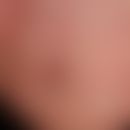Synonym(s)
Change of the nail colour; Colour change of the nails; Nail discoloration
DefinitionThis section has been translated automatically.
Discoloration of the nails (nail surface, nail plate and/or subungual tissue).
ClassificationThis section has been translated automatically.
- Grey or grey-blue nail coloration:
- Argyrie (slate grey; rare today)
- Phenolphthalein
- metastatic malignant melanoma
- Mercury chloride.
- Red or red-blue nail colouring:
- two-dimensional: fresh haematoma
- fine linear from the free nail edge:
- Blue or blue-brown (diffuse) nail colouring:
- Blue discoloration in combination of cardiac vitium and cyanotic flail fingers and toes
- Medicines: Minocycline, Mepacrin, Chloroquine, Doxyrubicin
- Systemic diseases: M. Wilson.
- Green or green-black nail colouring:
- Pseudomonas infections (green discoloration due to the fluorescent dye of the pathogens, pyoverdin)
- Mould infection (see Tinea unguium below).
- Yellow or yellow-brown nail colouring:
- Tinea unguium (filamentous fungi)
- After application of nail polish
- After application of potassium permanganate baths
- Oil stain, psoriatic
- Smoker (cigarette or cigar smoker)
- Systemic drugs (tetracyclines possibly in combination with sunlight exposures; see below) onycholysis, drug-induced or light-induced)
- Systemic diseases (e.g. Yellow-nail syndrome).
- Orange nail color:
- After application of nail polish
- Carrot Icterus ( Aurantiasis cutis)
- After working with azo dyes.
- Brown or brown-black nail colouring:
- narrow or broad band longitudinal linear
- Melanin inclusions
- Melanonychia striata longitudinalis (clarification of dignity!).
- Bounded centrally or laterally (never embedded in the nail matrix in stripes (check at the free end of the nail)
- Older nail hematoma.
- narrow or broad band longitudinal linear
- Diffuse homogeneous nail coloration:
- M. Addison
- Older nail hematoma: colour mostly deep black (especially on the big toe nail)
- Medicines (cyclophosphamide; chlorpromazine)
- Large malignant melanoma or large melanocytic nevus
- In combination with onychogrypose and polyneuropathy in elderly people
- Working materials (e.g. photo developer).
- White discolorations (see below Leukonychie).
You might also be interested in
ClinicThis section has been translated automatically.
- Colour anomalies depend on the nail bed, the transparency and adherence of the nail.
- Cause for a nail discoloration can be:
- Overproduction of melanin (longitudinal or complete brown or black discoloration) (see below for an overview of melanonychia)
- Formation of coloured new formations of the nail bed (e.g. glomus tumour).
- Colour deposits (homogeneously large-area, circumscribed, striped lengthwise or crosswise) in the nail bed and/or the nail matrix e.g.:
- Haematomas (see below haematoma, nail haematoma)
- copper, silver or mercury (e.g. in the case of M. Wilson or the Argyrie)
- various drugs (e.g. tetracyclines)
- Infections (inclusions of coloured microbiological products, e.g. green-blue due to Pseudomonas aeruginosa infection = green nail syndrome).
- Surface discolorations (e.g. chemicals, most frequently by coloured nail varnish); a preferential discoloration of the proximal nail wall can be caused by professional substances (e.g. potassium permanganate) or external agents (e.g. in smokers). A discoloration of the distal lunula border indicates an internal disease.
- White discoloration of the nails represents a polyätiological colour change of the nail plate (see below leukonychia).
Progression/forecastThis section has been translated automatically.
Since nails also contain melanin, their pigmentation level corresponds to their ethnic origin. The darker the skin, the darker the nails. Multiple dark stripes are widespread in dark-skinned Africans, in white Europeans they are to be distinguished with regard to their dignity (see below Melanonychia striata longitudinalis).
LiteratureThis section has been translated automatically.
- Haneke E (2013) Nail diseases. dermatologist 54: 519-532
- Hengge UE et al (2009) Green nails. New Engl J Med 360: 1125
- Roh M et al (2007) A case of chromonychia with hyperbilirubinemia. J Eur Acad Dermatol Venereol 21: 127-128
Incoming links (5)
Dyschromia; Erythronychia; Leukonychie; Nail discoloration; Onycholysis drug-induced or light-induced;Outgoing links (18)
Addison's disease; Argyria; Chloroquine; Cutis aurantiasis; Erythronychia longitudinalis;; Glomus tumor; Leukonychie; Melanonychia; Melanonychia striata; Minocycline; ... Show allDisclaimer
Please ask your physician for a reliable diagnosis. This website is only meant as a reference.




